Moxa Technologies AirWorks AWK-3131A User manual
- Category
- Routers
- Type
- User manual
This manual is also suitable for

AirWorks AWK-3131A User’s Manual
Version 7.1, June 2019
www.moxa.com/product
© 2019 Moxa Inc. All rights reserved.

AirWorks AWK-3131A User’s Manual
The software described in this manual is furnished under a license agreement and may be used only in accordance
with the terms of that agreement.
Copyright Notice
© 2019 Moxa Inc. All rights reserved.
Trademarks
The MOXA logo is a registered trademark of Moxa Inc.
All other trademarks or registered marks in this manual belong to their respective manufacturers.
Disclaimer
Information in this document is subject to change without notice and does not represent a commitment on the part of
Moxa.
Moxa provides this document as is, without warranty of any kind, either expressed or implied, including, but not
limited to, its particular purpose. Moxa reserves the right to make improvements and/or changes to this manual, or to
the products and/or the programs described in this manual, at any time.
Information provided in this manual is intended to be accurate and reliable. However, Moxa assumes no responsibility
for its use, or for any infringements on the rights of third parties that may result from its use.
This product might include unintentional technical or typographical errors. Changes are periodically made to the
information herein to correct such errors, and these changes are incorporated into new editions of the publication.
Technical Support Contact Information
www.moxa.com/support
Moxa Americas
Toll
-free: 1-888-669-2872
Tel:
+1-714-528-6777
Fax:
+1-714-528-6778
Moxa China (Shanghai office)
Toll
-free: 800-820-5036
Tel:
+86-21-5258-9955
Fax:
+86-21-5258-5505
Moxa Europe
Tel:
+49-89-3 70 03 99-0
Fax: +49-89-3 70 03 99-99
Moxa Asia
-Pacific
Tel:
+886-2-8919-1230
Fax: +886-2-8919-1231
Moxa India
Tel:
+91-80-4172-9088
Fax:
+91-80-4132-1045

Table of Contents
1. Introduction ...................................................................................................................................... 1-1
Overview ........................................................................................................................................... 1-2
Package Checklist ............................................................................................................................... 1-2
Product Features ................................................................................................................................ 1-2
Functional Design ............................................................................................................................... 1-3
LED Indicators ............................................................................................................................ 1-3
Beeper ....................................................................................................................................... 1-5
Reset Button ............................................................................................................................... 1-5
Relay (Digital Output) .................................................................................................................. 1-5
2. Getting Started.................................................................................................................................. 2-1
First-time Installation and Configuration ................................................................................................ 2-2
Communication Testing ....................................................................................................................... 2-3
Function Map ..................................................................................................................................... 2-5
3. Web Console Configuration ............................................................................................................... 3-1
Web Browser Configuration .................................................................................................................. 3-2
Overview ........................................................................................................................................... 3-4
Quick Setup ....................................................................................................................................... 3-5
General Setup .................................................................................................................................... 3-8
System Information ..................................................................................................................... 3-8
Interface On/Off .......................................................................................................................... 3-9
Network Settings ....................................................................................................................... 3-10
System Time ............................................................................................................................ 3-12
Wireless LAN Setup ........................................................................................................................... 3-13
AeroMag .................................................................................................................................. 3-14
Operation Mode......................................................................................................................... 3-19
Basic WLAN Setup ..................................................................................................................... 3-20
WLAN Security Settings.............................................................................................................. 3-23
Advanced WLAN Settings ........................................................................................................... 3-30
WLAN Certificate Settings (for EAP-TLS in Client/Client-router/Slave mode only) ............................... 3-34
Advanced Setup ............................................................................................................................... 3-35
Using Virtual LAN ...................................................................................................................... 3-35
Configuring Virtual LAN .............................................................................................................. 3-36
DHCP Server (for AP/Client-router mode only) .............................................................................. 3-37
Packet Filters ............................................................................................................................ 3-39
RSTP Settings (Master or Slave mode only) .................................................................................. 3-42
Static Route (for Client-router mode only) .................................................................................... 3-44
NAT Settings/Port Forwarding (for Client-router mode only) ........................................................... 3-45
SNMP Agent.............................................................................................................................. 3-48
Link Fault Pass-through (for Client/Slave mode only) ..................................................................... 3-50
Logs and Notifications ....................................................................................................................... 3-50
System Logs ............................................................................................................................. 3-50
Syslog ..................................................................................................................................... 3-52
E-mail Notifications.................................................................................................................... 3-53
Relay ....................................................................................................................................... 3-54
Trap ........................................................................................................................................ 3-54
Status ............................................................................................................................................. 3-56
Wireless LAN Status ................................................................................................................... 3-56
Associated Client List (for AP/Master mode only) ........................................................................... 3-57
DHCP Client List (for AP mode only) ............................................................................................. 3-57
System Logs ............................................................................................................................. 3-58
Relay Status ............................................................................................................................. 3-58
DI and Power Status .................................................................................................................. 3-59
AeroLink Protection Status (for Client/Slave mode only) ................................................................. 3-59
System Status .......................................................................................................................... 3-60
Network Status ......................................................................................................................... 3-60
Maintenance .................................................................................................................................... 3-62
Console Settings ....................................................................................................................... 3-62
Ping ......................................................................................................................................... 3-62
Firmware Upgrade ..................................................................................................................... 3-63
Configuration Import and Export ................................................................................................. 3-63
Load Factory Default .................................................................................................................. 3-64
Account Settings ....................................................................................................................... 3-64
Change Password ...................................................................................................................... 3-66
Misc. Settings ........................................................................................................................... 3-66
Troubleshooting ........................................................................................................................ 3-67
Save Configuration ........................................................................................................................... 3-70
Restart ............................................................................................................................................ 3-70
Logout............................................................................................................................................. 3-71

4. Software Installation and Configuration ........................................................................................... 4-1
Overview ........................................................................................................................................... 4-2
Wireless Search Utility ......................................................................................................................... 4-2
Installing Wireless Search Utility ................................................................................................... 4-2
Configuring Wireless Search Utility ................................................................................................ 4-5
5. Using Other Consoles ........................................................................................................................ 5-1
RS-232 Console Configuration (115200, None, 8, 1, VT100) .................................................................... 5-2
Configuration by Telnet and SSH Consoles ............................................................................................. 5-3
Configuration by Web Browser with HTTPS/SSL ...................................................................................... 5-4
Disabling Telnet and Browser Access ..................................................................................................... 5-5
A. References ........................................................................................................................................ A-1
AeroLink Protection ............................................................................................................................. A-2
Beacon .............................................................................................................................................. A-3
DTIM ................................................................................................................................................. A-3
Fragment ........................................................................................................................................... A-3
RTS Threshold .................................................................................................................................... A-4
STP and RSTP .................................................................................................................................... A-4
The STP/RSTP Concept ................................................................................................................ A-4
Differences between RSTP and STP ................................................................................................ A-4
B. Supporting Information .................................................................................................................... B-1
Firmware Recovery ............................................................................................................................. B-2
Declaration of Conformity .................................................................................................................... B-3
Federal Communication Commission Interference Statement ............................................................ B-3
RED Compliance Statement.................................................................................................................. B-4

1
1. Introduction
The AWK-3131A industrial a/b/g/n high speed wireless Access Point products are ideal wireless solutions for
hard-to-wire applications that use mobile equipment connected over a TCP/IP network. The AWK-3131A is
rated to operate at temperatures ranging from -25 to 60°C for standard models and -40 to 75°C for wide
temperature models, and is rugged enough for any harsh industrial environment.
The following topics are covered in this chapter:
Overview
Package Checklist
Product Features
Functional Design
LED Indicators
Beeper
Reset Button
Relay (Digital Output)

AirWorks AWK-3131A UM Introduction
1-2
Overview
The AWK-3131A is 802.11n compliant to deliver speed, range, and reliability to support even the most
bandwidth-intensive applications. The 802.11n standard incorporates multiple technologies, including
Spatial Multiplexing MIMO (Multi-In, Multi-Out), 20 and 40 MHz channels, and dual bands (2.4 GHz and 5
GHz) to provide high speed wireless communication, while still being able to communicate with legacy
802.11a/b/g devices.
The AWK's operating temperature ranges from -25 to 60°C for standard models and -40 to 75°C for wide
temperature models, and is rugged enough for all types of harsh industrial environments. Installation of the
AWK is easy using DIN-Rail mounting or distribution boxes, and with its wide operating temperature range,
IP30-rated housing with LED indicators, and DIN-Rail mounting it is a convenient yet reliable solution for all
types of industrial wireless applications.
Package Checklist
Moxa’s AWK-3131A is shipped with the following items. If any of these items is missing or damaged, please
contact your customer service representative for assistance.
• 1 AWK-3131A wireless AP/client
• 2.4/5 GHz antennas: ANT-WDB-ARM-0202
• DIN-rail kit
• plastic RJ45 protective caps
• Cable holder with one screw
• Quick installation guide (printed)
• Warranty card
NOTE
The above items
come with the standard AWK-3131A model, but the package contents may vary for
customized versions.
Product Features
• IEEE 802.11a/b/g/n compliant
• Advanced wireless security
64-bit and 128-bit WEP/WPA/WPA2
SSID Hiding/IEEE 802.1X/RADIUS
Packet access control & filtering
• STP/RSTP support for network system redundancy
• Long-distance transmission support (5 GHz channel only)
• Turbo Roaming enables rapid handover (Client mode)
• AeroLink Protection supported for redundant wireless communication
• ABC-01 for configuration import/export
• RS-232 console management
• 2DI+1DO for on-site monitoring and warnings
• Wide -40 to 75°C operating temperature range (-T model)
• Redundant 12 to 48 VDC power inputs or IEEE 802.3af Power over Ethernet
• DIN-Rail or wall mounting
• IP30 protected high-strength metal housing
NOTE
The latest specifications for Moxa’s products can be found at
https://www.moxa.com.

AirWorks AWK-3131A UM Introduction
1-3
ATTENTION
•
The AWK-3131A is NOT a portable mobile device and should be located at least 20 cm away from the
human body.
•
The AWK-3131A is NOT designed for the general public. A well-trained technician should be enlisted to
ensure safe deployment of AWK-3131A units, and to establish a wireless network.
Patent http://www.moxa.com/doc/operations/Moxa_Patent_Marking.pdf
Functional Design
LED Indicators
The LEDs on the front panel of the AWK-3131A provide a quick and easy means of determining the current
operational status and wireless settings.
The FAULT LED indicates system failures and user-configured events. If the AWK-3131A cannot retrieve the
IP address from a DHCP server, the FAULT LED will blink at half second intervals. The SIGNAL LEDs
indicate signal strength, and only operate in Client mode.

AirWorks AWK-3131A UM Introduction
1-4
The following table summarizes how to read the device’s wireless settings from the LED displays. More
information is available in Chapter 3 in the “Basic WLAN Setup” section.
LED Color State Description
Front Panel LED Indicators (System)
PWR1 Green
On Power is being supplied from power input 1.
Off
Power is not being supplied from power input 1.
PWR2 Green
On Power is being supplied from power input 2.
Off Power is not being supplied from power input 2.
PoE Amber
On Power is being supplied via PoE.
Off Power is not being supplied via PoE.
FAULT Red
On
System is booting up, or a system configuration error or
relay event has occurred.
Blinking
(fast at intervals of
0.5 second)
Cannot get an IP address from the DHCP server
Blinking
(slow at intervals
of 1 second)
IP address conflict
Off Error condition does not exist.
STATE
Green
On
System startup is complete and the system is in
operation.
Blinking
(fast at intervals of
0.5 second)
AeroLink Protection is enabled and is currently in
“Backup” state
Blinking
(slow
at intervals of
1 second)
Device has been located by Wireless Utility
(interval: 1 second)
Red On System is booting up
SIGNAL
(5 LEDs)
Green
On
Wi-Fi Signal Level (for Client/Slave/Client-Router Modes
only)
Off
WLAN
Green
On
WLAN function is in Client/Slave/Client-Router mode and
has established a link with an AP.
Blinking
WLAN data transmission is in Client/Slave/Client-Router
mode.
Off
WLAN is not in Client/Slave/Client-Router mode or has
not established a link with an AP.
Amber
On WLAN is in AP/Master mode.
Blinking WLAN data transmission is in AP/Master mode.
Off WLAN is not in use or not working properly
LAN
Green
On LAN port’s 1000 Mbps link is active.
Blinking
Data is being transmitted at 1000 Mbps.
Off LAN port’s 1000 Mbps link is inactive.
Amber
On LAN port’s 10/100 Mbps link is active.
Blinking Data is being transmitted at 10/100 Mbps.
Off LAN port’s 10/100 Mbps link is inactive.
ATTENTION
When the system fails to boot, the LEDs for
STATE (Green), FAULT, and WLAN will all light up
simultaneously and blink at one
-
second intervals. This may be due to improper operation or uncontrollable
issues, such as an unexpected shutdown while updating the firmware. To recover the firmware, refer to
the “Firmware
Recovery” section in Appendix B.

AirWorks AWK-3131A UM Introduction
1-5
Beeper
The beeper emits two short beeps when the system is ready.
Reset Button
The RESET button is located on the top panel of the AWK-3131A. You can reboot the AWK-3131A or reset it
to factory default settings by pressing the RESET button with a pointed object such as an unfolded paper
clip.
• System reboot: Hold the RESET button down for under 5 seconds and then release.
• Reset to factory default: Hold the RESET button down for over 5 seconds until the STATE LED starts
blinking green. Release the button to reset the AWK-3131A.
Relay (Digital Output)
The AWK-3131A has one relay output consisting of the 2 terminal block contacts on the top panel, as shown
below. These relay contacts are used to forward system failures and user-configured events.
The two wires attached to the relay contacts form an open circuit when a user-configured event is triggered.
If a user-configured event does not occur, the relay circuit will remain closed. For safety reasons, the relay
circuit is kept open when the AWK-3131A is not powered up.
Summary of the AWK-3131A’s Relay Status
Power Status Event Relay
Off – Open
On Yes Open
No
Short

2
2. Getting Started
This chapter explains how to install Moxa’s AirWorks AWK-3131A for the first time, and quickly set up your
wireless network and test whether the connection is running well. The Function Map discussed in the third
section provides a convenient means of determining which functions you need to use.
The following topics are covered in this chapter:
First-time Installation and Configuration
Communication Testing
Function Map

AirWorks AWK-3131A UM Getting Started
2-2
First-time Installation and Configuration
Before installing the AWK-3131A, make sure that all items in the Package Checklist are in the box. You will
need access to a notebook computer or PC equipped with an Ethernet port. The AWK-3131A has a default IP
address that must be used when connecting to the device for the first time.
• Step 1: Select the power source.
The AWK-3131A can be powered by a DC power input or PoE (Power over Ethernet). The AWK-3131A
will use whichever power source you choose.
• Step 2: Connect the AWK-3131A to a notebook or PC.
Since the AWK-3131A supports MDI/MDI-X auto-sensing, you can use either a straight-through cable or
crossover cable to connect the AWK-3131A to a computer. The LED indicator on the AWK-3131A’s LAN
port will light up when a connection is established.
• Step 3: Set up the computer’s IP address.
Choose an IP address on the same subnet as the AWK-3131A. Since the AWK-3131A’s default IP address
is 192.168.127.253, and the subnet mask is 255.255.255.0, you should set the IP address of the
computer to 192.168.127.xxx.
NOTE
After you
select Maintenance Load Factory Default and click the Submit button, the AWK-3131A
will be reset to
factory default settings and the IP address will be reset to 192.168.127.253.
• Step 4: Use the web-based manager to configure the AWK-3131A
Open your computer’s web browser and type http://192.168.127.253 in the address field to access
the homepage of the web-based Network Manager. Before the homepage opens, you will need to enter
the user name and password as shown in the following figure. For first-time configuration, enter the
default user name and password and then click on the Login button:

AirWorks AWK-3131A UM Getting Started
2-3
NOTE
Default user name and password:
User Name: admin
Password: moxa (starting with firmware version 1.4)
root (up to firmware version 1.3)
For security reasons, we strongly recommend changing the default password. To do so,
select
Maintenance Password, and then follow the on-screen instructions to change the password.
NOTE
After you click
Submit to apply changes the web page will refresh (Updated) will appear on the page
and
a blinking reminder will be shown on the upper
-right corner of the web page:
To activate the changes click
Restart and then Save and Restart
after you change the settings. About 30
seconds are need
ed for the AWK-3131A to complete the reboot procedure.
• Step 5: Select the AWK-3131A operation mode.
By default, the AWK-3131A’s operation mode is set to AP. You can change to Client mode in Wireless
LAN Setup
WLAN
Basic WLAN Setup. Detailed information about configuring the AWK-3131A’s
operation can be found in Chapter 3.
• Step 6: Test communications.
In the following sections we describe two test methods that can be used to ensure that a network
connection has been established.
Communication Testing
After installing the AWK-3131A you can run a sample test to make sure the AWK-3131A and wireless
connection are functioning normally. Two testing methods are described below. Use the first method if you
are using only one AWK-3131A device, and use the second method if you are using two or more AWK-
3131A units.
How to Test One AWK-3131A
If you are only using one AWK-3131A, you will need a second notebook computer equipped with a WLAN
card. Configure the WLAN card to connect to the AWK-3131A (the default SSID is MOXA), and change the
IP address of the second notebook (Notebook B) so that it is on the same subnet as the first notebook
(Notebook A), which is connected to the AWK-3131A.
After configuring the WLAN card, establish a wireless connection with the AWK-3131A and open a DOS
window on Notebook B. At the prompt, type
ping <IP address of notebook A>
and then press Enter (see the figure below). A “Reply from IP address …” response means the
communication was successful. A “Request timed out.” response means the communication failed. In this
case, recheck the configuration to make sure the connections are correct.

AirWorks AWK-3131A UM Getting Started
2-4
How to Test Two or More AWK-3131A Units
If you have two or more AWK-3131A units, you will need a second notebook computer (Notebook B)
equipped with an Ethernet port. Use the default settings for the first AWK-3131A connected to notebook A
and change the second or third AWK-3131A connected to notebook B to Client mode, and then configure the
notebooks and AWK-3131A units properly.
After setting up the testing environment, open a DOS window on notebook B. At the prompt, type:
ping <IP address of notebook A>
and then press Enter. A “Reply from IP address …” response means the communication was successful. A
“Request timed out” response means the communication failed. In this case, recheck the configuration to
make sure the connections are correct.

AirWorks AWK-3131A UM Getting Started
2-5
Function Map
General Setup for administering the AWK-3131A
Essential settings related to establishing a
wireless network
Advanced features to support additional network
management and secure wired and wireless
communication
NOTE: These advanced functions are all optional.
Quick overview of the AWK-3131A’s status

AirWorks AWK-3131A UM Getting Started
2-6
The management functions are categorized in a tree and shown in the left field of the web-based management
console. You can efficiently locate the function you need with this guide.
Current status information for monitoring wired/wireless
network performance, advanced services, and device
management functions.
Functions for maintaining the AWK-3131A, and for
diagnosing the network.
On-demand functions to support the web-based
console management operation.
Application-oriented device management functions
to set up events, traps, and reactions via relay
warning, e-mail, and SNMP notification
NOTE: These functions are all optional.

3
3. Web Console Configuration
In this chapter, we explain all aspects of web-based console configuration. Moxa’s easy-to-use management
functions help you set up your AWK-3131A and make it easy to establish and maintain your wireless
network.
The following topics are covered in this chapter:
Web Browser Configuration
Overview
Quick Setup
General Setup
System Information
Network Settings
System Time
Wireless LAN Setup
AeroMag
Operation Mode
Basic WLAN Setup
WLAN Security Settings
Advanced WLAN Settings
WLAN Certificate Settings (for EAP-TLS in
Client/Client-router/Slave mode only)
Advanced Setup
Using Virtual LAN
Configuring Virtual LAN
DHCP Server (for AP/Client-router mode only)
Packet Filters
RSTP Settings (Master or Slave mode only)
Static Route (for Client-router mode only)
NAT Settings/Port Forwarding (for Client-
router mode only)
SNMP Agent
Link Fault Pass-through (for Client/Slave
mode only)
Logs and Notifications
System Logs
Syslog
E-mail Notifications
Relay
Trap
Status
Wireless LAN Status
Associated Client List (for AP/Master mode
only)
DHCP Client List (for AP mode only)
System Logs
Relay Status
DI and Power Status
AeroLink Protection Status (for Client/Slave
mode only)
System Status
Network Status
Maintenance
Console Settings
Ping
Firmware Upgrade
Configuration Import and Export
Load Factory Default
Account Settings
Change Password
Misc. Settings
Troubleshooting
Save Configuration
Restart
Logout

AirWorks AWK-3131A UM Web Console Configuration
3-2
Web Browser Configuration
Moxa AWK-3131A’s web browser interface provides a convenient way to modify its configuration and access
the built-in monitoring and network administration functions. The recommended web browser is Microsoft
®
Internet Explorer 7.0 or 8.0 with JVM (Java Virtual Machine) installed.
NOTE
To use the
AWK-3131A’s management and monitoring functions from a PC host connected to the same
LAN as the
AWK-3131A, you must make sure that the PC host and the AWK-3131A are on the same
logical subnet. Similarly, if the
AWK-3131A is configured for other VLAN settings, you must make sure
your PC host is on the management VLAN.
Moxa
AWK-3131A’s default IP is 192.168.127.253.
Follow these steps to access the AWK-3131A’s web-based console management interface.
1. Open your web browser (e.g., Internet Explorer) and type the AWK-3131A’s IP address in the address
field. Press Enter to establish the connection.
2. The Web Console Login page will open. Enter the password (default Username = admin; default
Password = moxa) and then click Login to continue.
3. You may need to wait a few moments for the web page to download to your computer. Note that the
Model name and IP address of your AWK-3131A are both shown in the title bar of the web page. This
information can be used to help you identify multiple AWK-3131A units.
If an incorrect username or password is entered, a warning message is displayed. The system will lock
the user account based on the settings configured in the Maintenance
Account Settings page. The
default retry count is 5 times and the default lockout time is 600 seconds.

AirWorks AWK-3131A UM Web Console Configuration
3-3
Once an account is locked, the user will have to wait out the duration of the lockout period before
retrying.
4. Use the Quick Setup function on the homepage to quickly set up the AWK or click on the Overview
button to see the basic device settings. The Import/Export function helps you back up the system or
to perform a system recovery from an existing backup.

AirWorks AWK-3131A UM Web Console Configuration
3-4
5. Click on the Home link to go back to the main page.
Use the menu tree on the left side of the browser to open the AWK-3131A functions.
In the following paragraphs, we describe each AWK-3131A management function in detail. A quick overview
is available in this manual in the “Function Map” section of Chapter 3.
NOTE
The model name of the
AWK-3131A is shown as AWK-3131A-XX, where XX indicates the country code.
The country code indicates the
AWK-3131A version and which frequencies it uses. We use AWK-3131A-
US
as an example in the following figures. (The country code and model name that appears on your
computer screen may be different than the one shown here.)
Overview
The Overview page summarizes the AWK-3131A’s current status. The information is categorized into
several groups: System Information, Device Information and 802.11 Information.
Click on the SSID link (MOXA) to see more detailed information on 802.11 settings, as shown in the
following figure:

AirWorks AWK-3131A UM Web Console Configuration
3-5
NOTE
The
802.11 Information that is displayed may be different for different operation modes. For example,
Current BSSID
, Signal strength, and SNR are only available under Client/Client-Router/Slave operation
modes.
Quick Setup
The AWK-3131A provides a quick setup wizard to help you configure the basic settings including device
information and wireless settings.
Page is loading ...
Page is loading ...
Page is loading ...
Page is loading ...
Page is loading ...
Page is loading ...
Page is loading ...
Page is loading ...
Page is loading ...
Page is loading ...
Page is loading ...
Page is loading ...
Page is loading ...
Page is loading ...
Page is loading ...
Page is loading ...
Page is loading ...
Page is loading ...
Page is loading ...
Page is loading ...
Page is loading ...
Page is loading ...
Page is loading ...
Page is loading ...
Page is loading ...
Page is loading ...
Page is loading ...
Page is loading ...
Page is loading ...
Page is loading ...
Page is loading ...
Page is loading ...
Page is loading ...
Page is loading ...
Page is loading ...
Page is loading ...
Page is loading ...
Page is loading ...
Page is loading ...
Page is loading ...
Page is loading ...
Page is loading ...
Page is loading ...
Page is loading ...
Page is loading ...
Page is loading ...
Page is loading ...
Page is loading ...
Page is loading ...
Page is loading ...
Page is loading ...
Page is loading ...
Page is loading ...
Page is loading ...
Page is loading ...
Page is loading ...
Page is loading ...
Page is loading ...
Page is loading ...
Page is loading ...
Page is loading ...
Page is loading ...
Page is loading ...
Page is loading ...
Page is loading ...
Page is loading ...
Page is loading ...
Page is loading ...
Page is loading ...
Page is loading ...
Page is loading ...
Page is loading ...
Page is loading ...
Page is loading ...
Page is loading ...
Page is loading ...
Page is loading ...
Page is loading ...
Page is loading ...
Page is loading ...
Page is loading ...
Page is loading ...
Page is loading ...
Page is loading ...
Page is loading ...
Page is loading ...
Page is loading ...
Page is loading ...
Page is loading ...
-
 1
1
-
 2
2
-
 3
3
-
 4
4
-
 5
5
-
 6
6
-
 7
7
-
 8
8
-
 9
9
-
 10
10
-
 11
11
-
 12
12
-
 13
13
-
 14
14
-
 15
15
-
 16
16
-
 17
17
-
 18
18
-
 19
19
-
 20
20
-
 21
21
-
 22
22
-
 23
23
-
 24
24
-
 25
25
-
 26
26
-
 27
27
-
 28
28
-
 29
29
-
 30
30
-
 31
31
-
 32
32
-
 33
33
-
 34
34
-
 35
35
-
 36
36
-
 37
37
-
 38
38
-
 39
39
-
 40
40
-
 41
41
-
 42
42
-
 43
43
-
 44
44
-
 45
45
-
 46
46
-
 47
47
-
 48
48
-
 49
49
-
 50
50
-
 51
51
-
 52
52
-
 53
53
-
 54
54
-
 55
55
-
 56
56
-
 57
57
-
 58
58
-
 59
59
-
 60
60
-
 61
61
-
 62
62
-
 63
63
-
 64
64
-
 65
65
-
 66
66
-
 67
67
-
 68
68
-
 69
69
-
 70
70
-
 71
71
-
 72
72
-
 73
73
-
 74
74
-
 75
75
-
 76
76
-
 77
77
-
 78
78
-
 79
79
-
 80
80
-
 81
81
-
 82
82
-
 83
83
-
 84
84
-
 85
85
-
 86
86
-
 87
87
-
 88
88
-
 89
89
-
 90
90
-
 91
91
-
 92
92
-
 93
93
-
 94
94
-
 95
95
-
 96
96
-
 97
97
-
 98
98
-
 99
99
-
 100
100
-
 101
101
-
 102
102
-
 103
103
-
 104
104
-
 105
105
-
 106
106
-
 107
107
-
 108
108
-
 109
109
Moxa Technologies AirWorks AWK-3131A User manual
- Category
- Routers
- Type
- User manual
- This manual is also suitable for
Ask a question and I''ll find the answer in the document
Finding information in a document is now easier with AI
Related papers
-
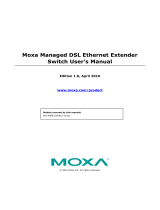 Moxa Technologies IEX-408E-2VDSL2 series User manual
Moxa Technologies IEX-408E-2VDSL2 series User manual
-
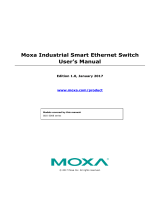 Moxa Technologies SDS-3008 Series User manual
Moxa Technologies SDS-3008 Series User manual
-
 Moxa Technologies ABC-02 Series Quick Install Guide
Moxa Technologies ABC-02 Series Quick Install Guide
-
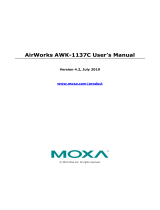 Moxa Technologies AWK-1137C Series User manual
Moxa Technologies AWK-1137C Series User manual
-
Moxa Technologies AirWorks AWK-3191 User manual
-
Moxa Technologies Switch EDS-726 User manual
-
 Moxa Technologies AWK-3131A-M12-RTG Quick Install Guide
Moxa Technologies AWK-3131A-M12-RTG Quick Install Guide
-
 Moxa Technologies AWK-3131A-RTG Series Quick Install Guide
Moxa Technologies AWK-3131A-RTG Series Quick Install Guide
-
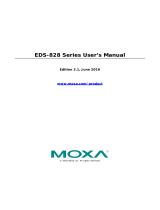 Moxa Technologies EDS-828 Series User manual
Moxa Technologies EDS-828 Series User manual
-
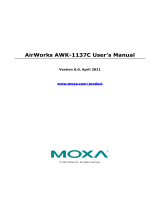 Moxa Technologies AWK-1137C Series User manual
Moxa Technologies AWK-1137C Series User manual
Other documents
-
Moxa AWK-3131A Series User manual
-
Moxa TN-5500A Series User manual
-
Moxa A-CAP-N-M Specification
-
Moxa EDS-510E Series User manual
-
Amer Networks WLAGP User guide
-
Encore ENRXWI-G User guide
-
Moxa AWK-3131A Series Quick setup guide
-
Moxa AWK-3131A Series Quick setup guide
-
Moxa ICS-G7826A Series User manual
-
Moxa PT-7728 Series User manual




















































































































